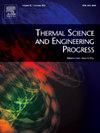太阳能驱动系统的技术经济优化,该系统集成了Kalina循环、热电发电机、双流体有机朗肯循环和反渗透淡化,用于维持体育场馆
IF 5.1
3区 工程技术
Q2 ENERGY & FUELS
引用次数: 0
摘要
这项研究集成了一个由抛物面槽太阳能集热器供电的太阳能场、一个由热电发电机增强的Kalina循环、一个双流体有机朗肯循环和一个反渗透淡化装置,为环保的体育场馆提供可持续的电力和淡水。从能源、能源和财务角度进行了综合技术经济评价。计算仿真代码用于灵敏度分析,以确定关键设计特征。系统的性能通过广泛的参数研究进行评估,重点放在高太阳辐射位置,由于其有利的环境条件,拉萨作为案例研究。研究结果表明,在双流体有机朗肯循环中,增加丁烷质量分数最初会提高蒸发速率和输出功率,在质量分数为0.2时达到峰值。超过这一点,由于蒸发器工作模式的变化,性能下降,影响传热率和整体系统效率。将蒸发器1的温度从195°C调节到215°C,增加了能量输入,但降低了总体净发电量。增加蒸发器3的温度最初增强发电,在60°C达到峰值。根据气象资料和系统动态分析,拉萨的发电量在夏季达到峰值,7月份发电量为12671.53兆瓦时。这种增加的产量通过降低能源成本来提高体育场馆的盈利能力。此外,每年794,809.53立方米的淡水产量可满足各种运营需求,进一步提高了财务可持续性。优化过程显著提高了作业效率,有效利用率达14.598%,投资回收期为4.041年。本文章由计算机程序翻译,如有差异,请以英文原文为准。
Techno-economic optimization of a solar-driven system integrating the Kalina cycle, thermoelectric generators, dual-fluid organic Rankine cycle, and reverse osmosis desalination for sustaining sports stadiums
This study integrates a solar field powered by parabolic trough solar collectors, a Kalina cycle enhanced by thermoelectric generators, a dual-fluid organic Rankine cycle, and a reverse osmosis desalination unit to provide sustainable electricity and freshwater for an eco-friendly sports arena. A comprehensive techno-economic evaluation was conducted, considering energy, exergy, and financial perspectives. Computational simulation code was used in a sensitivity analysis to identify key design characteristics. The system’s performance was assessed through extensive parametric studies, focusing on high solar radiation locations, with Lhasa serving as the case study due to its favorable environmental conditions. The findings indicate that increasing the Butane mass fraction in the dual-fluid organic Rankine cycle initially boosts evaporation rates and power output, peaking at a mass fraction of 0.2. Beyond this point, performance declines due to changes in evaporator operating modes, affecting heat transfer rates and overall system efficiency. Adjusting the Evaporator1 temperature from 195 to 215 °C enhances energy input but reduces overall net power production. Increasing Evaporator 3′s temperature initially enhances power generation, peaking at 60 °C. According to meteorological data and system dynamic analysis, electricity generation in Lhasa reaches its peak during the summer months, with July contributing 12,671.53 MWh. This increased output enhances the profitability of sports arenas by reducing energy costs. Additionally, annual freshwater production of 794,809.53 cubic meters supports various operational needs, further boosting financial sustainability. The optimization process markedly improved operational efficiency, achieving an exergetic performance of 14.598 % and setting a payback period of 4.041 years.
求助全文
通过发布文献求助,成功后即可免费获取论文全文。
去求助
来源期刊

Thermal Science and Engineering Progress
Chemical Engineering-Fluid Flow and Transfer Processes
CiteScore
7.20
自引率
10.40%
发文量
327
审稿时长
41 days
期刊介绍:
Thermal Science and Engineering Progress (TSEP) publishes original, high-quality research articles that span activities ranging from fundamental scientific research and discussion of the more controversial thermodynamic theories, to developments in thermal engineering that are in many instances examples of the way scientists and engineers are addressing the challenges facing a growing population – smart cities and global warming – maximising thermodynamic efficiencies and minimising all heat losses. It is intended that these will be of current relevance and interest to industry, academia and other practitioners. It is evident that many specialised journals in thermal and, to some extent, in fluid disciplines tend to focus on topics that can be classified as fundamental in nature, or are ‘applied’ and near-market. Thermal Science and Engineering Progress will bridge the gap between these two areas, allowing authors to make an easy choice, should they or a journal editor feel that their papers are ‘out of scope’ when considering other journals. The range of topics covered by Thermal Science and Engineering Progress addresses the rapid rate of development being made in thermal transfer processes as they affect traditional fields, and important growth in the topical research areas of aerospace, thermal biological and medical systems, electronics and nano-technologies, renewable energy systems, food production (including agriculture), and the need to minimise man-made thermal impacts on climate change. Review articles on appropriate topics for TSEP are encouraged, although until TSEP is fully established, these will be limited in number. Before submitting such articles, please contact one of the Editors, or a member of the Editorial Advisory Board with an outline of your proposal and your expertise in the area of your review.
 求助内容:
求助内容: 应助结果提醒方式:
应助结果提醒方式:


